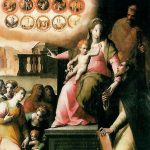The canvas located in the Propositura of Saints Hippolytus and Cassian, around 1587, was commissioned to the Florentine painter Giovanni Balducci, known as il Cosci (1560–post 1631), who was raised in the household of his maternal uncle, Raffaello Cosci. He was a pupil and collaborator of Giovan Battista Naldini (ca. 1537–1591), a Florentine painter and follower of Pontormo. Like his master, Balducci can be considered one of the artists still connected to the late Mannerist style and the Vasarian tradition. The work was commissioned by the local Compagnia del Rosario and San Giuseppe, the namesake confraternity of Laterina, whose mother superior was Donna Dolfa de Bertis, a name that can be found on the front panel of the throne, almost centrally, where the Virgin is seated.
The artwork followed the fate of the Company (which was dissolved before 1906) and the church. When the northern door was closed and the new altar of the Suffrage dedicated to the Madonna del Rosario was erected, the painting was removed from the altar and placed above the entrance portal. In 1986, it was entrusted to the Superintendence of Arezzo for restoration and was reinstalled in the church in 1997.
The fresco depicts the Virgin Mary offering the Rosary to Saint Dominic and showing the fifteen mysteries, represented within beaded circles at the top left of the painting. In addition to the depiction of the Madonna with the Child, we can see Saint Dominic, traditionally believed to have established the Holy Rosary, positioned at the far right of the painting. He is kneeling in devotion to the Virgin. Behind Mary’s shoulders stands another bearded, gray-haired figure holding a staff, identifiable as Saint Joseph, to whom the Confraternity was originally dedicated. On the left side, we find the young sisters who were members of the congregation.
Despite being dated 1587, the painting is first mentioned in the 1709 inventory by the provost Luigi Luciani in his manuscript from the first half of the 19th century:
“[…] The painting had a wooden frame, partly painted and partly gilded […]”, as this is the oldest document that lists in detail the furnishings of the Propositura of Saints Hippolytus and Cassian.
Manola Rosadini




